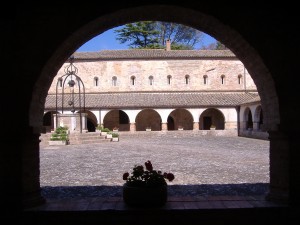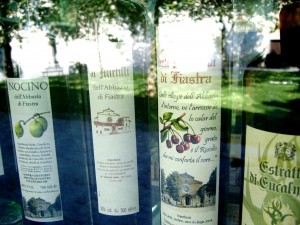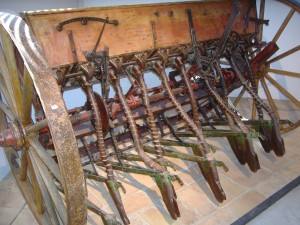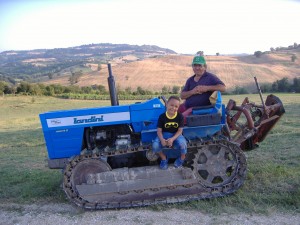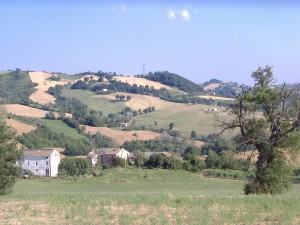Interesting ichthyological juxtaposition today in the old feed reader. While kids scour the few, small remaining pools of water for catfish in a parched Botswana, over in a specially stocked lake in Thailand, sports anglers catch a giant dog-eating catfish. 1 I really like the idea of Lake Monster, where anglers can come and pit their wits, and strength, against those of some of the biggest — and rarest — of freshwater fish. Nice way to take pressure off the natural populations, while assembling an artificial fish diversity hotspot for study purposes. I guess a botanical equivalent would be the gardens of medicinal herbs established by and for traditional healers.
The Abbadia di Fiastra
So I guess you’ll have gathered the family and I were on holiday in the Marche region last week. One of the cooler places we visited was the Abbadia di Fiastra (that’s its cloister above). This is a romanesque abbey nestled in the middle of an ancient wood, which is now a protected area. Cistercian monks built the place in the 12th Century, reclaimed some of the land for agriculture by changing the course of the river Entogge, and also made use of the nearby forest, of course. You can still buy natural products made on the abbey’s land in the little shop in the visitors’ centre.
There’s an interesting Museum of Peasant Culture at the abbey. Actually it mainly consists of old farm machinery and utensils. This was one of the more interesting exhibit, a seminatrice, or seed sower.
I talked to my friend the farmer about it. He remembers when tractors first came into the region, in the sixties. He remembers sowing and harvesting using machines such as this, pulled by horses or cows. He had heard of the museum, but didn’t think much of the idea.
Fruits galore
Always nice to see exotic fruits finding their way into markets. That seems to have happened with baobab – of all things – in the UK. And it may be on its way for the goji berry.
Vino cotto
We’d seen the signs a couple of time on the road from Macerata. Vino cotto. Easy enough to translate, but what the heck is it? Cooked wine: gotta be more to it than that, surely.
A bit, but not that much, as it turns out. I found out by accident. We locked ourselves out of the house, I had to get to Colmurano to locate the spare key, our own car keys were in the house, of course, but a friendly neighbourhood farmer gave me a lift — and we got talking. Here he is, and no, that’s not what he drove me into town with.
All the local farmers make vino cotto, but the best stuff comes from Loro Piceno, apparently. You heat the must in a large copper pot, down to half the volume. Then you store it in oak casks. For years, occasionally topping up the water. We tried a bit when we got back from getting the spare keys. My friend found some stuff in his garage that he thought was about forty years old. Or maybe fifty, he wasn’t sure. It was sweet but not too sweet, thick but not too thick, with a kind of burnt, caramelized, vaguely nutmeggy feeling to it. Hard to take in quantity on a hot summer day, but perfect for a cold winter night, I’m sure.
Wikipedia has some information on vino cotto, but the Italian version is much better than the English. And you can see the whole process on Casey Cole’s blog on low-carbon living in the Marche. 2
Over his vino cotto, and then also his red wine, of which I ended up taking home a gallon, the farmer told me about what it’s like to till the land in the Marche. This is what the landscape looks like: that’s his alfalfa field in the foreground, and his farmhouse on the left. What you can’t see is his wheat, ready to harvest, and his sunflowers. 3
It’s a hard life. He can’t really make ends meet. The fodder (straw and alfalfa hay) gets trucked up north as nobody has any cattle around there now. A few sheep, maybe, that’s all. The local cheese is a nice pecorino, but the women don’t make it anymore. Kids aren’t interested in life on the land, just motorinos and smack. They used to have 24 people working on the farm, now it’s just him and his brother, two retirees. Skyrocketing agricultural prices? News to them. But at least they have their vino cotto.
Conserving palms
Two palm stories were in the news yesterday. First, from Brazil, how a local community is changing its ways in an effort to exploit the juçara palm (Euterpe edulis) more sustainably. Then, from India, news of a biotechnological trick to determine the sex of palmyrah palms without having to wait for them to grow up.
I’ve been having to do rather more thinking about palm conservation than is altogether comfortable at work lately — coconut is such a beast, really. That, and these stories, and the need for some displacement activity got me googling. Kew and the Fairchild Tropical Botanic Garden seem to be at the forefront of palm conservation. There have been some successes in the field, but I’m beginning to think that at least for coconut the best bet may be Roland Bourdeix’s islet idea.
